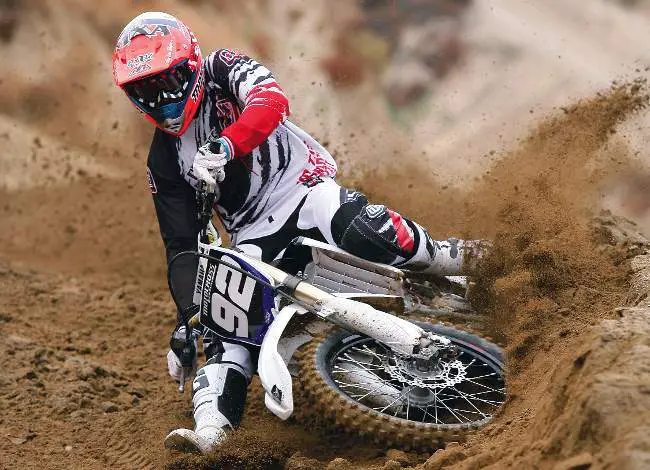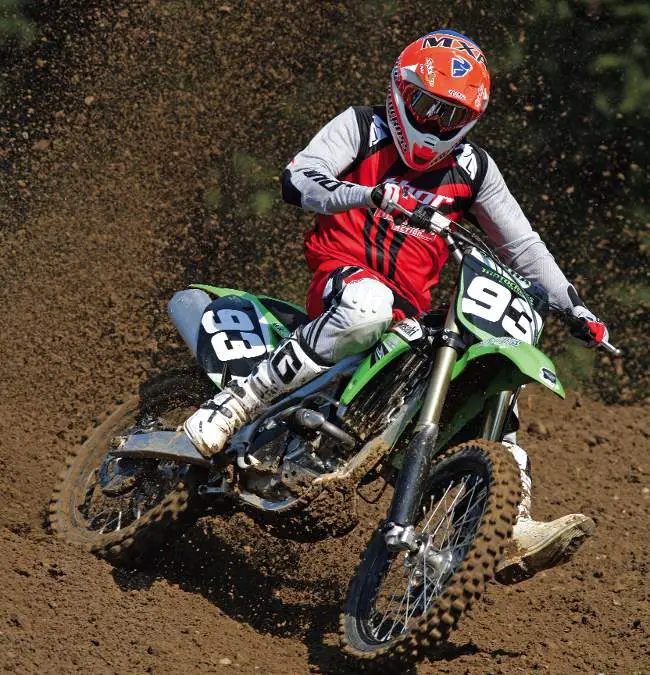MOTOCROSS ACTION’S 2011 250 FOUR-STROKE SHOOTOUT: HOW THEY RANK AGAINST EACH OTHER & WHAT YOU NEED TO KNOW BEFORE YOU BUY

We live in a world of constant judgment. Critical eyes and biased opinions are everywhere. Everyone has an opinion on everything?even stuff they know nothing about. Sadly, one man’s opinion is another man’s resource for a fact. Ignorance compounds ignorance until the overall IQ of the populace is reduced. The world wide web functions like the rats during the Bubonic Plague outbreak. It spreads misinformation with fleas of stupidity and it infects the minds of the masses with half-truths and outright lies at an alarming rate. Rumors and Internet gossip, even though based on faulty information, become truth to those without discernment.
So whom should you trust? How can you get accurate information? Where should you turn when you need to know the truth? Forget what you’ve heard from your well-meaning friends or read on the message boards. If you are talking about cancer info, hollywood gossip or Rachael Ray recipes, MXA isn’t the place to go. But, when the talk turns to testing motocross bikes, the MXA test riders have ridden, raced, dissected and torn apart all of the 2011 250 four-stroke motocross bikes to the point of exhaustion. We have the bikes, the time, the experience and the expertise to sniff out the facts. Behold MXA‘s 2011 250Four-Stroke Shootout. It is nothing if its not accurate and truthful.
FIFTH PLACE
HONDA CRF250

In one word: “Confused.” Honda has a reputation for being in the technological forefront, but making tech leaps of faith can sometimes lead a company astray. In short? The 2011 Honda CRF250 is a confused bike. We hark back to the glory year of 2009 when the CRF250 won MXA‘s 250 Shootout. Yet in two short years, Honda went from the front of the pack to the back of the bus. How did this happen? Honda threw the baby out with the bath water by switching to a controversial new frame and not-ready-for-prime-time electronic fuel injection. The result? The bike oversteered and the engine lacked breadth. Sometimes technological advancements aren’t all they’re cracked up to be. The 2011 Honda CRF250 is a prime example.Power: The CRF250 engine is a midrange-only monster. The MXA wrecking crew mostly blames the electronic fuel injection for the hollow-feeling power output. While the dreaded CRF250 carburetor bog is gone, we would gladly choose a hard-hitting engine over an unexciting one. The CRF250 is competitive in the hands of the right rider, but it takes a crafty throttle hand to keep the ponies pumping with such a narrow powerband.
Suspension: The Showa suspension might be excellent, but most people will never know it. Why? The forks dive, the chassis suffers from terminal headshake, and the shock wallows. Is it fixable? Yes, but you have to follow these five steps in order to improve the performance of the suspension: (1) Install stiffer fork springs. (2) Drop the fork tubes down in the triple clamps. (3) Tighten the steering stem nut. (4) Go stiffer on the HPSD steering damper. (5) Buy a longer aftermarket shock linkage arm.
Handling: The MXA wrecking crew will describe the handling of the 2011 Honda CRF250 with our rose colored glasses on. If you aren’t afraid of massive headshake down straights and can live with a front end that tucks under in tight turns, then you will love the CRF250. That is, if you can keep the bike from submarining into the ground.
The word: The 2011 Honda CRF250 finished last in MXA’s 250 Shootout for three reasons. The engine is far too mellow, the frame geometry is scary, and the suspension is poorly set up.

To read the complete CRF250 test click here
FOURTH PLACE
YAMAHA YZ250F

In one word: “Archaic.” How could the MXA wrecking crew be so cruel? The Yamaha YZ250F engine hasn’t undergone any major changes since Bill Clinton was in office. In all seriousness, Yamaha needs to kick out the jams with the YZ250F. It’s a venerable machine that desperately needs a modern powerplant. For 2011, the YZ250F didn’t receive any quality updates. The bold new graphics and different-colored radiator shrouds aren’t aesthetically groundbreaking, either. Even so, we cannot deny that the YZ250F is the most durable bike in the class and has very good suspension. For now, the YZ250F sits firmly in fourth place.
Power: The 2011 YZ250F has a pleasant engine, which sounds nice if you’re describing a waitress, but in moto speak it equates to a weak powerband. The YZ250F is the king of bottom-end power, but Yamaha needs to move the meat of the powerband into the midrange if they want to be taken seriously. Shift the YZ250F often to maximize its miniscule power spread.
Suspension: For all of our complaints with the engine, we don’t harbor any negativity towards Kayaba’s SSS suspension. It’s not perfect (the fork springs are soft for anyone over 150 pounds and the oil height is high), but once dialed in it’s the best stuff in the class. As is, the YZ250F is in a dead heat with the 2011 Suzuki RM-Z250 in the suspension department.
Handling: The YZ250F received a frame change in 2010. Yamaha opted for a 20-piece, bilateral-beam, aluminum frame, which was stronger and provided better lateral and torsional rigidity. As a result, the YZ250F handles quite well in most circumstances. It’s not the sharpest turning bike, but it can hold its own.
The word: Although we have been saying it for almost ten years, we would salute Yamaha if they developed a new engine for the YZ250F. We respect the YZ250F for what it is, but we dream of what it could be.
THIRD PLACE
KTM 250SXF

In one word: “Improvement.” How can we say such a thing when the KTM 250SXF earned runner-up honors last year while finishing third in 2011? It’s elementary, my dear Watson. KTM didn’t rest on their laurels. They went for the gusto by switching to an all-new linkage suspension system, revised chromoly frame and electronic fuel injection. Most important, KTM zeroed in on the engine, making a host of refinements for a more rider friendly powerband. KTM went in the right direction, but once the dust cleared, the Kawasaki KX250F edged out the KTM 250SXF for second place by a nose.
Power: Don’t expect the 250SXF engine to emit any sort of explosive power off the bottom end. The powerband is more rocket ship than Olympic sprinter, but KTM is beginning to find their way towards making the ultimate midrange 250 engine. Peak horsepower has never been an issue with the KTM 250SX. Instead, most test riders complained that the powerband was still too linear for their tastes. KTM could improve their stock in the 250 class for 2012 by punching up the midrange.
Suspension: We loved KTM’s new WP linkage system, but we hated how the suspension was undersprung on both ends. After jumping up a spring rate in the forks, lowering the fork oil, adding a stiffer shock spring and clicking around with the low-speed compression, we found happiness. However, that’s an awful lot of work (not to mention the big price tag) to get the suspension dialed in.
Handling: The KTM 250SXF is the only bike in the 250 class to use a steel frame, and boy are we glad! The steel frame is lightweight and feels narrow. KTM has the second-best-handling bike in the class behind the Suzuki RM-Z250.
The word: KTM needs to fix a few flaws on the 250SXF. They need to: (1) Stiffen up the spring rates?front and rear. (2) Kick the linear feel of the powerband to the curb. (3) Beware of the soft Excel rims. (4) Replace the Bonneville Salt Flats rear sprocket and gear the 250SXF down.
SECOND PLACE
KAWASAKI KX250F

In one word: “Surprising.” Having won MXA‘s 250 Shootout four out of the last five years, Kawasaki was expected to continue dominating the class. Wrong. Although the KX250F underwent nearly 30 changes for 2011, they weren’t all for the better. The Digital Fuel Injection hampered the personality of the KX250F’s once potent powerband, effectively taking the bite out of the dog. Interestingly enough, Kawasaki improved the handling of their 250 and incorporated a radically different Showa Separate Function Fork (SFF) suspension system. These changes allowed the KX250F to hang on to second place, but the engine’s shortcomings hindered the once mighty Kawasaki’s chances of getting first place.
Power: Don’t get us wrong, the 2011 KX250F has a very competitive powerband, but the snap has been replaced by an electric feel. The KX250F needs to be ridden in the top end for maximum effectiveness, as lugging the engine will result in it going nowhere fast. With all of the pluses and minuses of Kawasaki’s fuel-injected engine, the KX250F powerplant still ranks second among all 250s.
Suspension: Kawasaki took the technological plunge in terms of suspension advancement by electing to use Showa’s new SFF system. The right fork leg houses a spring that is twice as firm as the two springs found in conventional forks. The left fork leg contains the piston rod damper, air chamber and most of the fork oil (but no spring). Testers were pleasantly surprised by the performance of the SFF system and liked that the fork preload could be adjusted via a fork cap dial. However, the shock still has a tendency to wallow under acceleration. We replaced the stock link arm with a longer lowering link. This change helped significantly.
Handling: The KX250F has never been described as the best handling bike, but the 2011 KX250F handles better than its green predecessors. It still has a tendency to push from center-out in corners, but that characteristic isn’t as prominent as in years past. The KX250F isn’t even close to being the best handling bike in the class, but it’s decent.
The word: We commend Kawasaki for taking a technological leap forward, but they paid a price for going to fuel injection. The electric-feeling KX250F powerband is that price.
FIRST PLACE
SUZUKI RM-Z250

In one word: “Shocking!” We were pleasantly surprised after slinging a leg over the 2011 Suzuki RM-Z250 the first time, and that excitement hasn’t diminished in the months since. In years past, the RM-Z250 has cornered like a dream, but that positive attribute was overshadowed by its soft powerband and equally soft suspension. No more! Suzuki addressed all of their major issues. As a result, the RM-Z250 is the winner of the 2011 MXA 250 Shootout.
Power: Gone is the bottom-end-only powerband. In place of the one-dimensional engine is a powerplant that rips through the midrange and can hold its own in the top end. We’re happy that Suzuki made this power tradeoff, because a 250 is meant to be ridden hard. There is very little regard for bottom-end power in the ranks of hardcore 250 racers. They want to rev?and so does the 2011 RM-Z250. As a result, the RM-Z250 has the best engine in a class where powerband is king.
Suspension: It’s worth mentioning that for the first time in the RM-Z250’s existence, the bike is properly suspended. In years past, the suspension was severely undersprung for any rider over 150 pounds. Now the Showa suspension holds itself up in the stroke and works incredibly well for most riders. Apart from the Yamaha YZ250F, the Suzuki RM-Z250 has the best ballpark fork and shock settings. Kudos.
Handling: The RM-Z250 has no equal in the handling department. It can hit lines that its competition will breeze right by. The only real downfall of the RM-Z250’s frame geometry is that the front end suffers from moderate headshake down rough straights. That issue can be solved with backyard fixes like sliding the forks down and tightening the steering stem.
The word: The 2011 Suzuki RM-Z250 has the best engine in the class. It also takes the cake in the handling department, and the “carbureted feel” of Suzuki’s fuel injection system is a marvel. The RM-Z250 won MXA‘s 250 Shootout hands down. Welcome to the top, Suzuki.










Comments are closed.